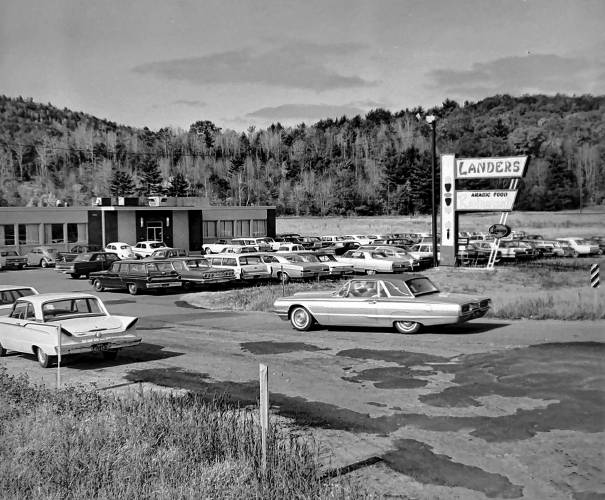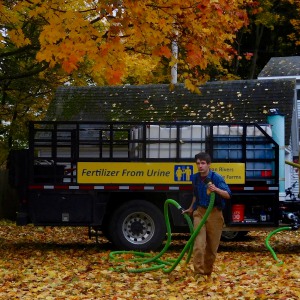A Look Back: Upper Valley dining scene changes with the times
|
Published: 05-05-2024 4:31 PM
Modified: 05-07-2024 11:43 AM |
Before franchised fast food and corporate-owned restaurants hit the Upper Valley, there was a time when locally owned diners and a variety of family-run eating establishments flourished and produced many fond memories and much nostalgia. For at least a quarter-century after World War II, that’s the way it was.
The first chain-type eating establishment to come to the region was a Howard Johnson’s in about 1949 when Windsor Brown obtained a franchise and set up shop at the edge of his dairy farm on U.S. Route 5 opposite the veteran’s hospital in White River Junction. It offered a standardized menu tailored to a family-choices audience, but the top item was the 28 flavors of ice cream, served up with scoops shaped like inverted cones.
A few A&W Root Beer franchises appeared in the early 1950s; they were primarily locally owned and tapped into the early craze for carhop service.
But the Valley’s dining scene then was dominated by establishments that were locally rooted and, likely as not, run by hands-on owners in the kitchens and visible among the tables, booths and counters. No matter the style or scale, successful operations proved over and over that standalone restaurants rarely succeed without active involvement of ownership.
It was the heyday of diners, eating places built in a factory with design influences from railroad dining cars. Their interiors typically had plenty of chrome, Naugahyde and colorful tile in the décor, and they could be slid onto a flatbed trailer and moved to a fresh location, such as the Four Aces in West Lebanon, which began life on North Main Street and later was relocated to a new spot on Bridge Street. Hanover had a diner tucked away on Allen Street until the early 1950s, when it was loaded up and hauled to Newport, where it would live out its days.
The Upper Valley at the peak of the diner phenomenon had at least 20 such establishments. West Lebanon had the aforementioned Four Aces, plus Andy’s down the other side of Main. White River Junction had the Polka Dot and Dick’s; Woodstock, the Wasp; Lebanon, the White Owl; there was the Windsor Diner and the Depot; Sharon had Brooksie’s; Royalton, the Atlantic; there was the Fairlee Diner and the Hartford Diner; and in Claremont, the Tumble Inn. Several of these live on; others have disappeared, often converted to scrap.
Today, much diner fare would be classed as comfort food, with simple meat entrees like pot roast and pork chops, accompanied by mashed potatoes with gravy and peas or green beans. There’d also be a mix of sandwiches, burgers and deep-fried items. Any diner worth its salt offered baked beans and pies for dessert. For many, the quality of the beans and the pie was the yardstick by which a diner could be judged.
Diners provided affordable food with quick service, which undergirded their appeal to working folks, though the Four Aces often fed hordes of beery Dartmouth students in the days it stayed open ’til midnight.
Article continues after...
Yesterday's Most Read Articles
 City cites Claremont property owner over demolition of building
City cites Claremont property owner over demolition of building
 NH search crew finds remains of long-missing hiker in remote wilderness area
NH search crew finds remains of long-missing hiker in remote wilderness area
 Appeal denied for Hanover man in child porn case
Appeal denied for Hanover man in child porn case
 Enfield Zoning Board approves variances for 300-unit development
Enfield Zoning Board approves variances for 300-unit development
 State, community members differ on plans for bridge spanning river between Charlestown and Springfield, Vt.
State, community members differ on plans for bridge spanning river between Charlestown and Springfield, Vt.
A traveling troupe of professional wrestlers came to Claremont about 1955 to put on a show and “Haystack” Calhoun, estimated to weigh over 400 pounds, showed up at the Tumble Inn, where he polished off an eight-egg omelet, a rasher of bacon and half a pie, at least. So large was he that his backside occupied two stools at the counter.
Not all Upper Valley diners were factory-built and hauled in from Worcester, Mass., and other far-off locales. A number were essentially storefronts or modest additions to commercial buildings. The formula was the same — generous servings of simple food at affordable prices. Food historians have called the diner a New England phenomenon, and without doubt diners were as ubiquitous in the region as frost heaves and town meetings.
Post-war, the Upper Valley saw steady change in the ways people entertained themselves. The coming of television did more to disrupt social activities and community life than any other development. People started skipping traditional diversions like locally produced plays and talent shows in favor staying home to watch Jackie Gleason, “Playhouse 90” and the “$64,000 Question” quiz show.
But they also began to eat out more often, and that brought a slow but steady increase in restaurants with table service, waitstaff and more varied menus. After years of wartime rationing, gasoline was readily available along with more reliable automobiles and improved roads, all of which enabled people to travel greater distances to enjoy restaurant meals. No longer did restaurants cluster in population centers; locations out in the countryside could be developed more cheaply, and issues that plagued downtown establishments like parking and space for expansion went away.
A perfect example was Lebanon’s Landers Restaurant, run by three Alafat brothers, Mickey, Dickie and Jimmy. The great Lebanon fire of 1964 and construction of a new Route 120 from Exit 18 off Interstate 89 to Hanover made them abandon an old location in the downtown area and build a whole new facility out on the new highway.
The new location led to a three-decade run in which Landers was jammed with customers night after night and drew regular patrons from as far away as Rutland, Vt., and Laconia, N.H. The Alafats featured Middle Eastern menu items, a great novelty in the Valley at the time. Broiled kebabs of lamb, peppers and onions with sides of deep fried tomato slices were a signature choice, but roast prime rib and other more conventional entrees were also offered.
Another Lebanon restaurant, Riverside Grill, was situated out in the country and it had a huge following in its heyday from the 1950s to the ’80s. It offered large portions of seafood accompanied by French fries and cole slaw, but its steaks were likewise a major draw. In 1957, a porterhouse, fries and slaw cost $1.75. Weekend evenings, there’d typically be a line snaking out the front door waiting for a table. There was no hostess seating patrons, who just watched for a table to be vacated and cleaned off before moving forward to sit down.
Riverside was run by two brothers, Harry and Stanley Laware. Their restaurant was hurt when highway construction limited access, and it would continue to function at a reduced scale until it finally closed in 2016. At the time of closure, it was the oldest New Hampshire restaurant still run by its founding family.
Without doubt, Landers and Riverside were the Upper Valley’s largest-volume restaurants of their time. But there were plenty of others that found their niche and prospered before the region was invaded by the corporate chains. In an industry where 85% fail within five years, those survivors invariably shared some important characteristics — on-site management by the owners; good reputations for food quality, service and value; and careful cost control.
Innovation or market sense could play a role in building success, too. Consider Alphonse “Ponzi” Falzarano, proprietor of the eponymous Ponzi’s at the Routes 4 and 5 split at the edge of White River Junction. Falzarano was ahead of the wave when pizza started taking off as a consumer favorite, especially among youth. Pizza would become America’s No. 1 entrée by the 1970s, but it took a while for skeptical Upper Valley residents to cotton to it. Ponzi showed the way and eventually other establishments were getting on board to the point where today pizza shops are the most common food establishments in the Upper Valley.
For high-end dining in the post-World War II years there were fixtures of the region’s hotels, such as the Hanover Inn, the Woodstock Inn, the Hotel Coolidge and the Windsor House. Today they might be called “date night” places, but back then there were a few standalones that still evoke fond memories for some, such as the Woodbine Cottage in Sunapee and the Rutledge Inn in Fairlee.
Speaking of memories, just about every person who attended an Upper Valley high school back in the 1950s can recall a favorite hangout. Hanover High kids flocked to Lou’s (still the anchor restaurant in downtown Hanover) for a small Coke and a slice of chocolate layer cake for just a quarter. Stevens High students clogged the booths at the Pleasant Sweet Shop. Windsor’s Cinderella Spa has its own lore. An author from across the river in Cornish liked to schmooze with the senior girls from Windsor High at the Spa after school. When he earned a mention in the school newspaper, it was the end of J.D. Salinger hanging with the senior girls. The Spa’s space years later was converted to a Pizza Chef restaurant, with actors Charles Bronson and Jill Ireland frequent patrons.
Liquor laws of the two states would play an important role in how the restaurant business evolved in the post-war years. New Hampshire’s alcohol regulation system was still heavily influenced by the state’s potent temperance movement decades after repeal of prohibition. For on-site consumption, it essentially set up levels of license for social classes. At the bottom was the “beer joint” license for the working people, at the top was a category for “Class A” hotels that allowed hard liquor to be dispensed to the upper crust, and in the middle was a frequently changing mix of how beverages could be served.
For years a New Hampshire regulation required waitstaff to carry the customers’ drinks any time they moved within the establishment, such as from the bar to the dining room. Some restaurant owners tried to just go without alcohol, but consumer expectations would eventually prevail while the state slowly changed its regulatory scheme.
Vermont started out similarly hidebound but liberalized policies more quickly. An argument has been made that one of the main reasons Vermont’s ski industry got ahead of New Hampshire’s was because it eased alcohol regulation much faster. When New Hampshire began taxing meals consumed outside the home, it soon realized that easing up on its arcane alcohol rules was good for the restaurant business — and the state treasury.
Steve Taylor lives in Meriden and contributes occasionally to the Valley News.







 Enfield Shaker Museum renovations underway
Enfield Shaker Museum renovations underway Art Notes: Canaan Meetinghouse showcase brings musicians and listeners together
Art Notes: Canaan Meetinghouse showcase brings musicians and listeners together The future of fertilizer? Pee, says this Brattleboro institute
The future of fertilizer? Pee, says this Brattleboro institute
